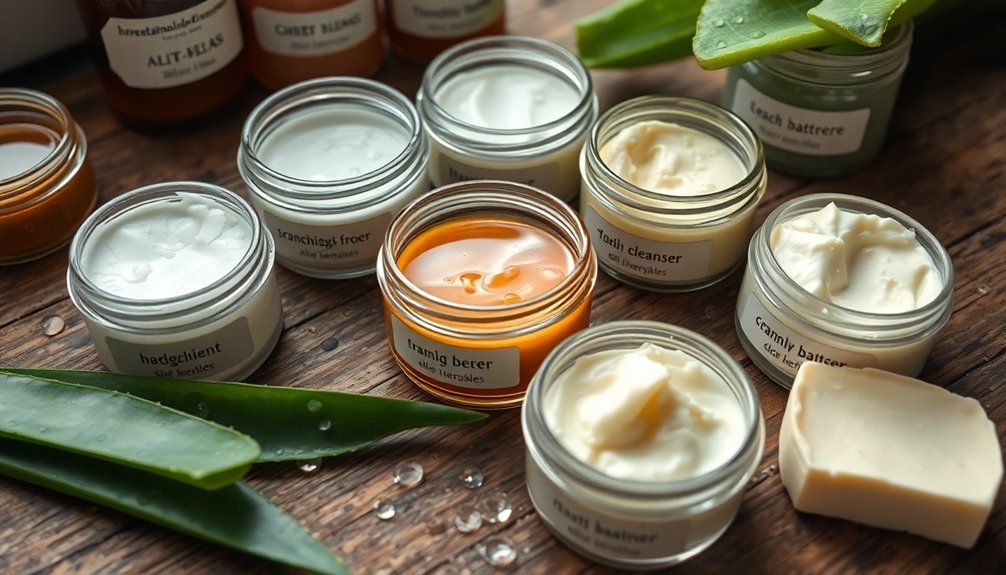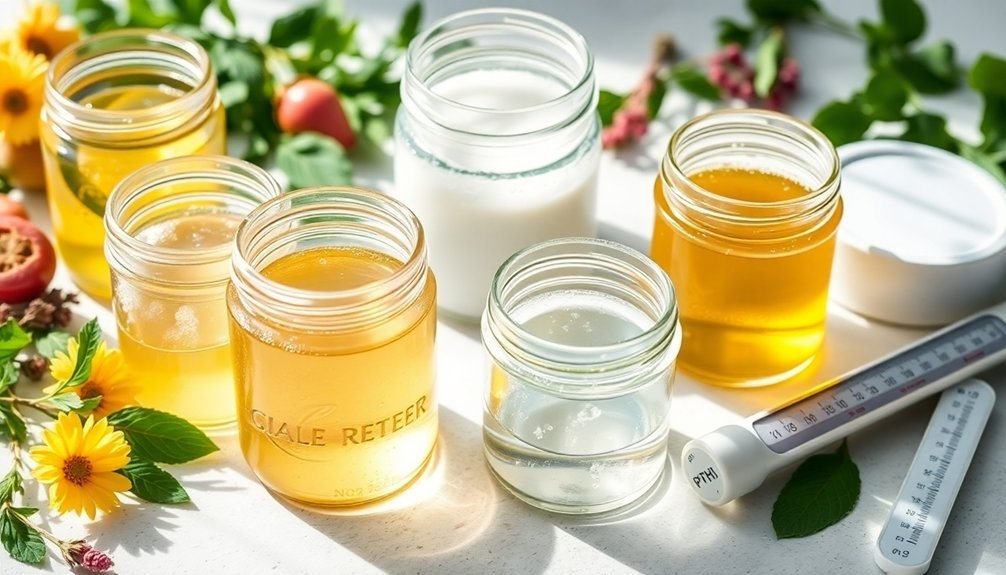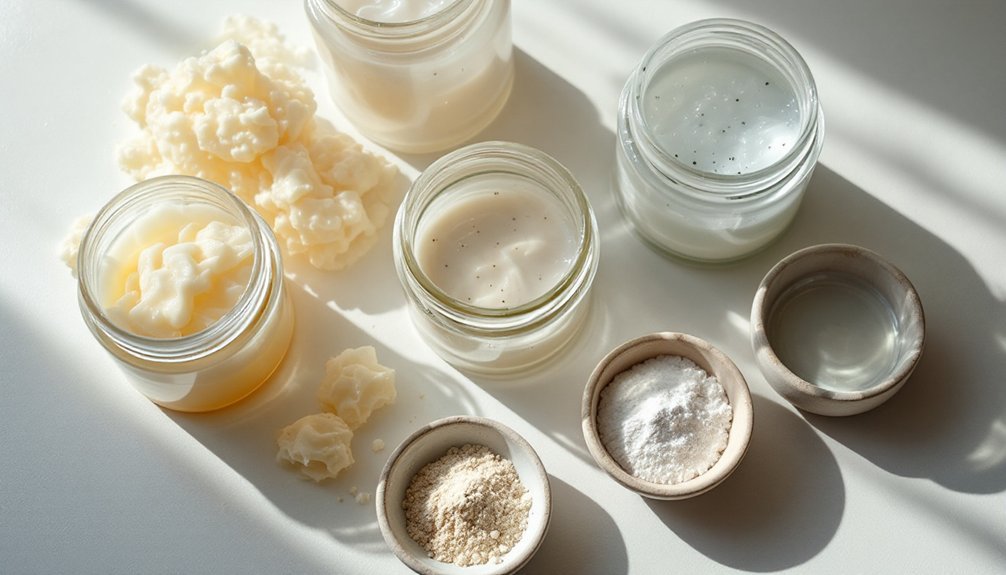Homemade cleansers often fail due to pH imbalance, comedogenic oils, and inadequate preservation. To fix these issues, test your cleanser's pH with strips and adjust with citric acid, swap coconut and olive oils for non-comedogenic alternatives like sunflower oil, and incorporate proper preservatives in water-based formulas. Don't rely solely on vitamin E or essential oils for preservation. These simple adjustments will transform your DIY skincare from potentially harmful to truly beneficial for your skin.
The Ph Imbalance Problem: Why Your Skin Feels Tight After Washing

When you wash your face with handmade cleansers, that tight, uncomfortable feeling afterward isn't just your imagination—it's science. Your skin naturally maintains an acidic pH between 4.5 and 5.5, creating a protective acid mantle that defends against environmental threats and microbes.
Many handmade cleansers inadvertently have a high pH that disrupts this delicate balance. These alkaline formulations strip away natural oils and fatty acids, compromising your skin barrier. The result? Immediate tightness, dryness, and increased water loss through your skin.
Over time, this pH disruption can lead to redness, sensitivity, breakouts, and even accelerated aging. Traditional soap-based cleansers can be especially problematic with their pH of 12, dramatically altering your skin's natural chemistry. Your skin's microbiome—beneficial bacteria that protect you—becomes unbalanced, making your skin more vulnerable to irritation and infection.
Oil Overload: When Comedogenic Ingredients Clog Your Pores
Beyond pH issues, another common mistake in homemade cleansers involves the oils you choose. Not all oils are created equal—some can severely clog your pores and trigger breakouts.
The comedogenic scale (0-5) measures an oil's pore-clogging potential. While coconut and olive oils are popular DIY choices, they rank high on this scale, making them risky for most skin types.
Not all oils belong on your face—coconut and olive oils rank dangerously high on the comedogenic scale.
Your well-intentioned cleanser might actually be causing acne, uneven texture, and inflammation.
If you're experiencing breakouts, switch to non-comedogenic alternatives like sunflower or squalane oil immediately. Reduce the quantity of oil in your formulations and incorporate regular exfoliation into your routine.
Always patch test new ingredients and consider your skin type before selecting oils—oily and acne-prone skin requires extra caution with low-rated options. Ingredients like cocoa butter and avocado oil should be avoided as they are highly comedogenic oils that almost guarantee pore congestion.
Preservation Predicament: Stopping Bacterial Growth In Your Handmade Cleanser

Perhaps the most overlooked danger in DIY skincare, bacterial contamination can transform your homemade cleanser from skin-saving to skin-damaging within days. Without proper preservation, water-based cleansers become bacterial breeding grounds. Maintaining a consistent, cool storage temperature significantly extends your product's shelf life.
| Preservation Method | Effectiveness | Best For |
|---|---|---|
| Broad-spectrum preservatives | High | All water-based formulas |
| Essential oils (tea tree, etc.) | Low-Medium | Supporting traditional preservatives |
| Airless packaging | Medium | Extending shelf life |
Don't rely on vitamin E or honey alone—they won't stop bacterial growth. Instead, use proper preservatives in your water phase, sterilize all equipment, and use distilled water. Remember that even "natural" cleansers need protection. Store products in cool, dark places and watch for changes in color, smell, or texture that might indicate contamination.
Frequently Asked Questions
Can I Use Kitchen Utensils for Making Facial Cleansers?
You shouldn't use regular kitchen utensils for facial cleansers due to bacterial contamination risks and chemical leaching. Instead, invest in dedicated stainless steel, glass, or specially designated tools for your skincare creations.
How Do Seasonal Changes Affect Homemade Cleanser Effectiveness?
Seasonal changes impact your homemade cleanser's effectiveness by altering your skin's moisture levels, barrier function, and pH balance. You'll need to adjust ingredients and formulations to match winter dryness or summer humidity changes.
Are Commercial Preservatives Safer Than Natural Alternatives?
Commercial preservatives aren't inherently safer than natural alternatives. You'll find each has trade-offs—commercial ones offer proven efficacy and consistency, while natural options may be gentler on skin and environmentally friendlier.
What Cleansing Tools Work Best With Handmade Products?
For handmade products, soft tools work best: cotton pads for gentle application, microfiber towels for drying, and soft bristle brushes for exfoliation. You'll get better results with tools matching your specific skin type.
How Do Handmade Cleansers Interact With Prescription Skincare Medications?
Handmade cleansers may interfere with your prescription medications due to incompatible ingredients, inconsistent pH levels, and lack of preservatives. You'll need to consult your dermatologist before combining them with prescribed treatments.
In Summary
You've learned the pitfalls of homemade cleansers and their solutions. Remember to balance pH levels to prevent that uncomfortable tight feeling, avoid comedogenic oils that clog pores, and don't skip proper preservation methods to keep bacteria at bay. With these fixes, you'll transform your failed DIY cleansers into effective skincare allies that nourish your skin while keeping it clean and healthy.





Leave a Reply